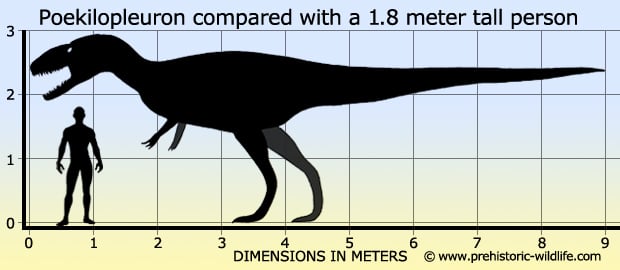[Recent Entries][Archive][Friends][User Info]
| November 11th, 2012 | |
|---|---|
| 06:12 pm [industrialterro] [Link] |
Poekilopleuron Poekilopleuron (meaning 'varied ribs') is an extinct genus of large basal tetanuran theropod dinosaur, perhaps belonging to the clade Allosauroidea. It measured 9 metres (30 feet) long and 1 ton (1 tonne) in mass. It dates from the Bathonian (Middle Jurassic), 168 to 165 million years ago. Poekilopleuron is known from a partial skeleton discovered by Jacques Amand Eudes-Deslongchamps in July 1835 near La Maladrerie in Normandy, France, in a layer of the Calcaire de Caen Formation. This skeleton, part of the collection of the Musée de la Facultée des Sciences de Caen, was in 1944 destroyed during the Battle of Caen in World War II, and the taxon has since had to be studied on the basis of cast replicas. One set is present in the Muséum National d'Histoire Naturelle in Paris with inventory number MNHN 1897-2, a second in the Yale Peabody Museum, YPM 4938. The remains consisted of caudal vertebrae, cervical ribs, ribs, gastralia or belly ribs, a forelimb and a hindlimb. Eudes-Deslongchamps named the type species Poekilopleuron bucklandii in 1837 or 1838. The generic name is derived from Greek poikilos, "varied", and pleuron, "rib", a reference to the three types of rib present. The specific name, honouring William Buckland, was deliberately identical to that of Megalosaurus bucklandii. Eudes-Deslongchamps thought the specimen might well be proven to belong to this earlier named species; if so, merely the generic name would have to be changed. Indeed, following 1879 Poekilopleuron was often subsumed under Megalosaurus bucklandii. Eudes-Deslongchamps' choice caused problems however, when Friedrich von Huene in 1923 concluded it was part of Megalosaurus but as a separate species within that genus. As both species carried the same epithet bucklandii, they could no longer be distinguished. Von Huene therefore renamed the species into Megalosaurus poekilopleuron. Most later authors continued using the generic name Poekilopleuron. Another problem was caused by the fact that the name was only partially Latinised. In correct Greek it would have been "poikilopleuron", in Latin "poecilopleurum". This induced later writers to improve the spelling, leading to such variants as Poecilopleuron and Poikilopleuron (still used as late as 2006). However, the original name has priority and is valid. Five other species would be named in the genus. In 1869 Edward Drinker Cope renamed Laelaps gallicus into Poekilopleuron gallicum. In 1870 Joseph Leidy created a Poicilopleuron valens based on a fossil probably belonging to Allosaurus. In 1876 Richard Owen named a Poikilopleuron pusillus, in 1879 renamed by Cope to Poekilopleuron minor; in 1887 Harry Govier Seeley made it a separate genus: Aristosuchus. In 1883 W.A. Kiprijanow created a Poekilopleuron schmidti, of which the specific name honours Friedrich Schmidt, based on some indeterminate ribs and a sauropod metatarsal. This chimaera is a nomen dubium. A much later named species is Poekilopleuron valesdunensis created by Ronan Allain in 2002. In 2005 it was renamed Dubreuillosaurus. The most distinctive feature of Poekilopleuron were its forelimbs. Their length, about 60 cm, was a sign of this theropod's more original build. Unlike later Theropoda, whose forelimbs tended toward reduction in length in proportion to the animals' size, Poekilopleuron's were long and, by implication, potent. The length mostly resided in the elongated but powerfully muscled humerus. The antebrachia (forearms) were markedly short and robust, a characteristic shared with Poekilopleuron's slightly later and considerably larger American cousin Torvosaurus. A unique feature is a lack of the olecranon process on the ulna. The fossil of Poekilopleuron showed a rare complete set of gastralia: fourteen pair of belly ribs supported the body of the animal. Because the original fossil was destroyed and no other remains of Poekilopleuron have since been found, and also because of its name change, there is much controversy surrounding its classification that cannot be resolved. Traditionally it has been assigned to the Megalosauridae, but some recent analyses showed a position in the Sinraptoridae; others had as result it was a member of Megalosauroidea, in a basal position or in the Eustreptospondylinae. Benson et al. (2010) found it and Lourinhanosaurus to belong to Sinraptoridae. The material of Poekilopleuron bucklandii includes two tail vertebrae with the chevron of one vertebra ankylosed to the centrum of the next within the development of an exostosis. Two phalanges also preserve pathologies. One probable pedal phalanx shows three low, irregular exostosis-like projections. A second probable manual phalanx exhibits a "low rounded projection resembling a callus." Ralph Molnar considered the occurrence of three pathologies in one individual to be "noteworthy". Sadly the specimens cannot be examined further to determine the etiology of the pathologies because of their destruction during the British bombing raid in 1944.
Размеры тела в сравнении с человеком:
Tags: Вымершие рептилии, Юра, авеметатарзалии, архозавроморфы, архозавры, диапсиды, динозавроморфы, динозавры, карнозавры, синрапториды, тероподы, ящеротазовые |



